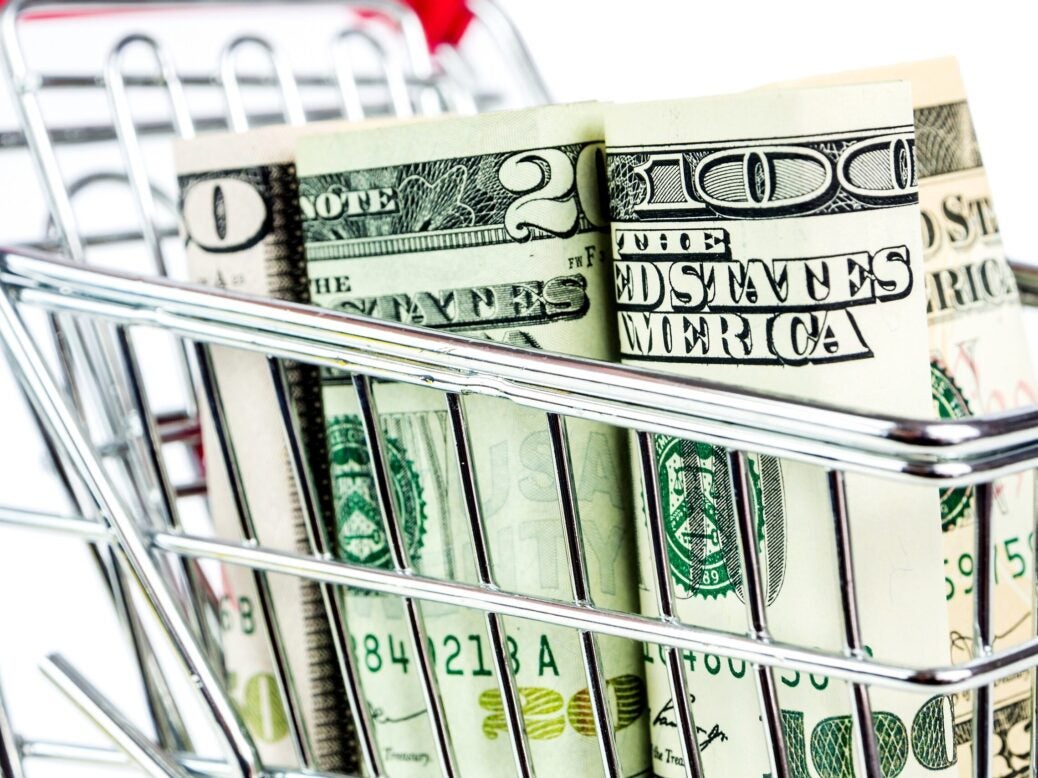
US shoppers are placing tricky and proceed to spend on packaged meals on the grocery retailer in spite of the truth inflation is operating at its easiest tempo since 1981.
However the present state of the American shopper is hard to get a care for on, one thing the CEOs of meals producers huge and small are looking to gauge as they care for vital and widespread charge will increase all the way through the provision chain, from elements and packaging to freight and labour.
The Convention Board’s Client Self belief Index launched on Wednesday (27 April) confirmed a slight lower for April, after an build up in shopper self belief in March. The bellwether Client Self belief Index now stands at 107.3, down from 107.6 in March.
The Provide Scenario Index – in line with shoppers’ review of present industry and hard work marketplace prerequisites – fell to 152.6 in April, from 153.8 closing month. On the other hand, the Expectancies Index – in line with shoppers’ non permanent outlook for source of revenue, industry and labour prerequisites – ticked as much as 77.2 from 76.7 in March.
Total, shopper sentiment is proving obscure.
What’s now not tricky to get a care for on is the rationale shopper self belief stays quite top. For viewpoint, in 1985, when inflation wasn’t as top as it’s at the moment, the bellwether Client Self belief Index was once at 100, seven issues less than it’s this April. In this day and age, American citizens are experiencing certainly one of the most up to date process markets in a long time, marked via low unemployment and top call for for staff, which is boosting wages.
Regardless of experiencing increased per thirty days grocery expenses for the reason that get started of the yr because of fast-rising inflation, shoppers proceed to spend on packaged meals, produce, dairy and contemporary meat on the grocery retailer. Salary will increase, both from current employers or completed via switching jobs, have equipped an inflationary cushion, no less than up to now.
How lengthy this may stay the case is just about unattainable to expect. The USA Federal Reserve, as an example, is trying to place the brakes on inflation via upping rates of interest however traditionally it takes a large amount of time to look sure effects from this tactic.
What’s more uncomplicated to expect is meals inflation isn’t going to leave anytime quickly, now not most effective as a result of inflation within the economic system but additionally because of the warfare in Ukraine. The ongoing provide chain boondoggle may be nonetheless an element. That hasn’t recovered from the pandemic shutdown and most probably received’t recuperate this yr, in particular with the shocks to agriculture and meals manufacturing brought about via Russia’s invasion of its neighbour.
US meals marketplace inflation appears set to proceed
In a brand new forecast launched this week, the International Financial institution warned the warfare in Ukraine is ready to reason the “greatest commodity surprise” for the reason that Seventies. In different phrases, the worst is but to return in relation to aspect prices for packaged meals firms and costs on the grocery retailer.
The record says to be expecting increased value will increase in the entirety from herbal fuel and petroleum to sunflower oil and wheat. Relating to agricultural commodities, wheat is forecast to extend 42.7% and succeed in new report highs in buck phrases. Different notable will increase predicted are 33.3% for barley, 20% for soybeans, 29.8% for oils and 41.8% for hen. The will increase may well be smaller for the USA as a result of its vital home agriculture manufacturing and output – however now not a lot much less.
Control groups at main publicly-held shopper packaged items firms like Nestlé, Unilever and Danone have additionally been pointing out publicly they be expecting endured charge will increase around the board and, consequently, be expecting to proceed reflecting the ones value will increase directly to wholesalers and outlets.
The truth is that, on this time of spiraling meals value inflation, packaged meals firms (particularly smaller early-stage and rising manufacturers as a result of they have got some distance fewer economies of scale than majors do) have little selection however to replicate those consistent and widespread will increase directly to their wholesale and retail companions, which in flip replicate the associated fee will increase to shoppers. There has additionally been numerous “margin consuming” taken already via manufacturers huge and small, which can also be an insidious follow if the chunk is simply too huge and lasts for too lengthy of a period. Freight charge will increase by myself are so widespread presently, as an example, that the share build up from one week or one month to the following in and of itself can devour a margin level or 3 out of a logo’s set gross margin.
There’s uncertainty even on the greatest and the most efficient packaged meals firms concerning the state of the shopper and inflation in the USA meals marketplace. We’re in quite uncharted territory with regards to fresh historical past.
Costs will proceed to need to be raised. One risk on this – and we’re already seeing it to a small stage – is shopper accept as true with in manufacturers and the business as an entire will erode. Value-sticker surprise on the grocery retailer could have that impact, as can public reviews of report income and profits via publicly-held packaged meals firms, a few of which we’ve been seeing in recent years.
Be clear on value
My best recommendation to packaged meals firms in relation to value will increase – and shoppers, in addition to retail and wholesale consumers, are stakeholders – is to be totally clear when making them. Manufacturers and the business wish to do a greater process of explaining to shoppers and consumers simply how severe the associated fee pressures are. In my paintings with manufacturers, as an example, I haven’t discovered one facet of the industry the place prices aren’t expanding and, most often, expanding frequently. Complete transparency would possibly sound trite nevertheless it isn’t. Doing so pays dividends for manufacturers.
This received’t be well liked by a large number of folks however I additionally endorse some average “shrinkflation,” or relief in package deal sizes. I’m now not even adversarial to manufacturers touting it. “We’ve diminished our 14-ounce package deal of boxed macaroni and cheese to 12oz as a substitute of elevating the associated fee,” they may say.
Shrinkflation should be accomplished on a product-specific foundation, and the dimensions of the shrink should be small. I don’t advise decreasing the dimensions of a gallon of milk (128 oz) to, say, even 127 oz. It’s an iconic product dimension within the minds of shoppers and nonetheless thought to be a staple.
However it labored for ice cream, which is extra of an indulgence merchandise within the minds of shoppers. In the USA meals marketplace, till the Nineties, the half-gallon (64 oz) of ice cream was once the usual. Other people even referred to the product via its dimension: a half-gallon of ice cream. These days, it’s exhausting to discover a half-gallon of ice cream that’s in fact a 64oz half-gallon. The 2 main nationwide manufacturers, adopted via maximum others, reduced in size the normal half-gallon all the way down to 56 oz. It was once diminished once more some years in the past to 48 oz, which it’s recently. Customers have accredited it, despite the fact that it’s gained a large number of dangerous press over time.
Recipe and packaging adjustments can play a task
Two further issues I counsel packaged meals firms imagine on this inflationary setting are aspect reformulation and packaging adjustments.
Basic Turbines has embarked at the former with a few of its manufacturers, substituting elements which might be easier and not more expensive to procure. Be mindful: we’re in an aspect scarcity economic system, in addition to a higher-cost-for-ingredients economic system. This can also be accomplished in lots of circumstances with out converting the style of a product and may end up in a cheaper price of products for the product, which cannot most effective beef up margin but additionally play a big function in how a lot to extend the price of a product. It’s one thing well-worth exploring for meals firms of all kinds and sizes.
Packaging is a space that gives doable charge financial savings for manufacturers, each in prices of products and doable freight financial savings. Paper prices much less to send than plastic and plastic prices much less to send than glass. The packaging selected should have compatibility the whole logo symbol however rebranding is this sort of not unusual factor lately it’s now not a big factor so long as the alternate in packaging isn’t accomplished in isolation from the opposite components that move into what makes a logo a logo.
I’m additionally beginning to see some innovation in the market, together with paper bottles to switch plastic. Actually, I be expecting the present setting will in fact spur all types of innovation, together with in packaging, delivery and aspect procurement. Such inventions take time to undergo fruit despite the fact that.
The remainder of the yr will see increasing prices around the board for packaged meals firms. Client self belief is unsure. If, as an example, unemployment rises considerably and the process marketplace contracts, leading to a pulling down of wages, it’s a wholly new ballgame, as would be the case if (as some economists are predicting) recession may come on the finish of the yr or in early 2023.
The brilliant spot up to now for firms in the USA meals marketplace is the price of consuming out is way increased than the price of consuming at house.
The disadvantage for main manufacturers is an important phase of shoppers is beginning to business all the way down to less-costly retailer manufacturers, despite the fact that up to now it hasn’t been an important hit for many manufacturers.
However that may alternate instant. And that is the place manufacturers, in particular the majors, wish to be additional wary when taking into consideration how a lot and the way ceaselessly to boost costs to retail and wholesale consumers.
Simply Meals columnist Victor Martino is a California-based strategic advertising and marketing and industry building guide, analyst, entrepreneur and author, specialising within the meals and grocery business. He’s to be had for session at: victorrmartino415@gmail.com and https://twitter.com/VictorMartino01.



